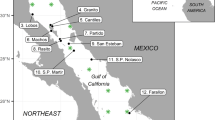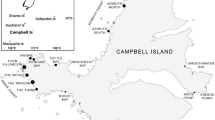Summary
A central tenet of Antarctic ecology suggests that increases in Chinstrap Penguin (Pygoscelis antarctica) populations during the last four decades resulted from an increase in prey availability brought on by the decrease in baleen whale stocks. We question this tenet and present evidence to support the hypothesis that these increases are due to a gradual decrease in the frequency of cold years with extensive winter sea ice cover resulting from environmental warming. Supporting data were derived from one of the first, major multidisciplinary winter expedition to the Scotia and Weddell seas; recent satellite images of ocean ice cover; and the analysis of long-term surface temperature records and penguin demography. Our observations indicate there is a need to pay close attention to environmental data in the management of Southern Ocean resources given the complexity of relating biological changes to ecological perturbations.
Similar content being viewed by others
References
Ainley DG (1985) Biomass of birds and mammals in the Ross Sea. In: Siegfried WR, Condy PR, Laws RM (eds) Antarctic nutrient cycles and food webs. Springer Berlin Heidelberg New York, pp 498–575
Ainley DG, Boekelheide RJ (1990) Seabirds of the Farallon Islands: ecology, structure and dynamics of an upwelling-system community. Stanford Univeristy Press, Palo Alto Calif
Ainley DG, Sullivan CW (1990) AMERIEZ 1988: a summary of activities on board M/V Polar Duke. Antarct J US 24:19–22
Ainley DG, LeReche RE, Sladen WJL (1983) Breeding ecology of the adelie penguin. University of California Press, Los Angeles Calif
Ainley DG, O'Connor EF, Boekelheide RJ (1984) The marine ecology of birds in the Ross Sea, Antarctica. Am Ornithol Union Monogr 32, Washington DC
Allison IF, Keage PL (1986) Recent changes in the glaciers of Heard Island. Polar Rec 23:255–271
Ashmole NP (1963) The regulation of numbers of tropical oceanic birds. Ibis Polar Rec 103:pp458–473
Bedard J (1976) Coexistence, coevolution and convergent evolution in seabird communities: a comment. Ecology 57:177–184
Birkhead TR, Furness RW (1985) Regulation of seabird populations. In: Sibly RM, Smith RH (eds) Behavioural ecology, ecological consequences of adaptive behaviour. Blackwell, London, pp 145–167
Birt VL, Birt TP, Goulet D, Cairns DK, Montevecchi WA (1987) Ashmole's halo: direct evidence for prey depletion by a seabird. Mar Ecol Prog Ser 40:205–208
Bolin B, Doos BR, Jager J, Warrick RA (eds) (1986) The greenhouse effect, climate change and ecosystems. Wiley, London, 541 pp
Bonner WN (1985) Impact of fur seals on the terrestrial environment at South Georgia. In: Siegfried WR, Condy PR, Laws RM (deds) Antarctic nutrient cycles and food webs. Springer, Berlin Heidelberg New York, pp 641–646
Brown SG, Lockyer CH (1984) Whales. In: Laws RM (ed) Antarctic ecology. Academic Press, San Diego Calif, pp 717–781
Brownell RL, Ainley DG (1976) Southern Elephant Seals in the Ross Sea. Antarct J US 11:189–190
Cline DR, Siniff DB, Erickson AW (1969) Summer birds of the pack ice in the Weddell Sea, Antarctica. Auk 86:701–716
Cody ML (1973) Coexistence, coevolution and convergent evolution in seabird communities. Ecology 54:31–44
Comiso JC, Zwally HJ (1989) Polar Microwave Brightness Temperatures from Nimbus-7 SMMR. Natl Aeronautics Space Admin Ref Publ 1223, Washington, DC
Conroy WH (1975) Recent increases in penguin populations in Antarctica and the Subantarctic. In: Stonehouse B (ed) The Biology of penguins. Macmillan, London, pp 321–336
Croxall JP, Kirkwood ED (1979) The breeding distribution of penguins on the Antarctic Peninsula and islands of the Scotia Sea. British Antarctic Survey, Cambridge, 188 pp
Croxall JP, Pilchner M (1984) Length-frequency distribution and sex ratio of krill eaten by Antarctic Fur Seals Arctocephalus qazella at South Georgia. Br Antarct Surv Bull 63:117–125
Croxall JP, Prince PA (1979) Antarctic seabird and seal monitoring studies. Polar Rec 19:573–595
Croxall JP, Prince PA (1980) Food, feeding ecology and ecological segregation of seabirds at South Georgia. Biol J Linn Soc 14:103–131
Croxall JP, Prince PA, Hunter I, McInnes SJ, Copestake PG (1984) The seabirds of the Antarctic Peninsula, islands of the Scotia Sea and Antarctic Continent between 80 °W and 20 °W: their status and conservation. In: Croxall JP, Evans PGH, Schreiber RW (eds) Status and conservation of the world's Seabirds. ICBP, Cambridge, pp 635–664
Croxall JP, Prince PA, Ricketts C (1985) Relationships between prey life-cycles and the extent, nature and timing of seal and seabird predation in the Scotia Sea. In: Siegfried WR, Condy PR, Laws RM (eds) Antarctic nutrient cycles and food, webs. Springer, Berlin Heidelberg New York, pp 516–533
Croxall JP, McCann TS, Prince PA, Rothery P (1988) Reproductive performance of seabirds and seals at South Georgia and Signy Island, South Orkney Islands, 1976–1987. Implications for Southern Ocean monitoring studies. In: Sahrhage D (ed) Antarctic ocean and resources variability. Springer, Berlin Heidelberg New York, pp 261–285
Emison WB (1968) Feeding preferences of the Adelie penguin at Cape Crozier, Antarctica. In: Austin OL (ed) Antarctic bird studies. Antarct Res Ser 12. Am Geophys Union, Washington DC, pp 191–212
Erickson AW, Hanson MB (1990) Continental estimates and population trends in Antarctic ice seals. In: Kerry KR, Hempel G (eds) Ecological change and the conservation of Antarctic ecosystems. Proc 5th SCAR Symp Antarct Biol, Hobart, August–September 1988. Springer Berlin Heidelberg New York, pp 253–264
Everson I (1977) The living resources of the Southern Ocean. FAO Southern Oceans Fishery Survey Programme GLO/SO/77/1, Rome
Fraser WR, Pitman RL, Ainley DG (1989) Seabird and fur seal responses to vertically migrating winter krill swarms in Antarctica. Polar Biol 10:37–41
Furness RW, Birkhead TR (1984) Seabird colony distribution suggests competition for food supplies during the breeding season. Nature 311:655–656
Garrison DL, Siniff DB (1986) An Antarctic perspective. BioScience 36:238–242
Heimark GM, Heimark RJ (1988) Observations of birds and marine mammals at Palmer Station, November 1985–November 1986. Antarct J US 23:14–17
Hibler WB (1984) The role of sea ice dynamics in modeling CO2 increases. In: Hansen JE, Takahashi T (eds) Climate processes and climate sensitivity. Am Geophys Union, Washington DC, pp 238–253
Hibler WB III, Ackley SF (1987) Numerical simulation of the Weddell Sea pack ice. J Geophys Res 88:2873–2887
Horwood JW (1980) Competition in the Antarctic? Rep Int Whal Commun 30:513–517
Husby DM, Muench RD, Gunn JT (1989) Oceanographic observations in the Scotia Sea marginal ice zone June–August 1988. NOAA Tech Mem NMFS, NOAA-TM-NMFS-SWFC-127
Jacka TH, Christou L, Cook BJ (1984) A data bank of mean monthly and annual surface air temperatures for Antarctica, the Southern Ocean and South Pacific Ocean. ANARE Res Notes 22
Jacka TH, Christou L, Cook BJ (1985) Updating the sea ice and climate monitoring programs. ANARE Res Notes 28:59–62
Joiris CR (1991) Spring distribution and ecological role of seabirds and marine mammals in the Weddell Sea, Antarctica. Polar Biol 11:415–424
Jones PD, Limbert DWS (1987) A data bank for Antarctic surface temperature and pressure data. US Dept on Energy, DOE/ER/60397 H-2
Jouventin P, Weimerskirch H (1990) Long-term changes in seabird and seal populations in the Southern Oceans. In: Kerry KR, Hempel G (eds) Ecological change and the conservation of Antarctic ecosystems. Proc 5th SCAR Symp Antarct Biol, Hobart, August–September 1988. Springer, Berlin Heidelberg New York, pp 208–213
Lack D (1954) The natural regulation of animal numbers. Clarendon Press, Oxford
Laws RM (1985) The ecology of the Southern Ocean. Am Sci 73:26–40
Lewis-Smith RI (1990) Signey Island as a paradigm of biological and environmental change in Antarctic terrestrial ecosystems. In: Kerry KR, Hempel (eds) Ecological change and the conservation of Antarctic ecosystems. Proc 5th SCAR Symp Antarct Biol, Hobart, August–September 1988. Springer, Berlin Heidelberg New York, pp 32–50
Lewis-Smith RI, Bonner WN (1989) Proposed construction of a crushed rock airstrip at Rothera Point, Adelaide Island, British Antarctic Territory. British Antarctic Survey, Cambridge
Lishman GS (1985) The comparative breeding biology of Adelie and Chinstrap penguins Pygoscelis adeliae and P. antarctica at Signey Island, South Orkney Islands. Ibis British Antarctic Survey, Cambridge 127:pp84–99
Murphy EJ, Morris DJ, Watkins JL, Priddle J (1988) Scales of interaction between Antarctic krill and the environment. In: Sahrhage D (ed) Antarctic ocean and resources variability. Springer, Berlin Heidelberg New York, pp 120–130
Murphy RC (1936) Oceanic birds of South America. Macmillan, New York
Parkinson CL, Bindschadler RA (1984) Responses of Antarctic sea ice to uniform atmospheric temperature increases. In: Hansen JE, Takahashi T (eds) climate processes and climate sensitivity. Am Geophys Union, Washington DC, pp 254–264
Parmelee DF, Parmelee JM (1987) Updated penguin distribution for Anvers Island, Antarctica. Br Antarct Surv Bull 76:65–73
Poncet S, Poncet J (1987) Censuses of penguin populations of the Antarctic Peninsula, 1983–87. Br Antract Surv Bull 77:109–129
Ribic CA, Ainley DG, Fraser WR (1991) Marine mammal habitat associations in the marginal ice zone of the Scotia/Weddell confluence region. Antarct Sci 3:181–186
Ricklefs RE (1973) Ecology. Chiron Press, Portland
Rootes DM (1988) The status of birds at Signey Island, South Orkney Islands. Br Antarct Surv Bull 80:87–119
Sladen WJL (1964) The distribution of the adelie and chinstrap penguins. In: Carrick R, Holdgate MW, Prevost J (eds) Biologie Antarctique. Hermann, Paris, pp 359–365
Trivelpiece WZ, Trivelpiece SG (1990) Courtship period of Adelie, Gentoo and Chinstrap penguins. In: Davis LS, Darby JT (eds) Penguin Biology. Academic Press, San Diego Calif, pp 113–126
Trivelpiece WZ, Trivelpiece SG, Volkman NJ (1987) Ecological separation of Adelie, gentoo and chinstrap penguins at King George Island, Antarctica. Ecology 68:351–361
Trivelpiece WZ, Trivelpiece SG, Geupel GR, Kjelmyr J, Volkman NJ (1990) Adelie and chinstrap penguins: their potential as monitors of the Southern Ocean marine ecosystem. In: Kerry KR, Hempel (eds) Ecological change and the conservation of Antarctic ecosystems. Proc 5th SCAR Symp Antarct Biol, Hobart, August–September 1988. Springer, Berlin Heidelberg New York, pp 191–202
Volkman NJ, Presler P, Trivelpiece WZ (1980) Diets of pygoscelid penguins at King George Island, Antarctica. Candor 82:373–378
Watson GE (1975) Birds of the Antarctic and Subantarctic. Am Geophys Union, Washington DC
Wilson EO (ed) (1988) Biodiversity. National Academy Press, Washington DC, 521 pp
Zwally HJ, Comiso JC, Parkinson CL, Campbell WJ, Carsey FD, Gloersen P (1983) Antarctic Sea Ice, 1973–1976: satellite passivemicrowave observations. Natl Aeronautics Space Admin, Washington DC
Author information
Authors and Affiliations
Rights and permissions
About this article
Cite this article
Fraser, W.R., Trivelpiece, W.Z., Ainley, D.G. et al. Increases in Antarctic penguin populations: reduced competition with whales or a loss of sea ice due to environmental warming?. Polar Biol 11, 525–531 (1992). https://doi.org/10.1007/BF00237945
Received:
Accepted:
Issue Date:
DOI: https://doi.org/10.1007/BF00237945




